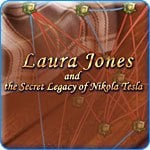- Wondering how to get Monopoly GO! free rolls? Well, you’ve come to the right place. In this guide, we provide you with a bunch of tips and tricks to get some free rolls for the hit new mobile game. We’ll …
Best Roblox Horror Games to Play Right Now – Updated Weekly
By Adele Wilson
Our Best Roblox Horror Games guide features the scariest and most creative experiences to play right now on the platform!The BEST Roblox Games of The Week – Games You Need To Play!
By Sho Roberts
Our feature shares our pick for the Best Roblox Games of the week! With our feature, we guarantee you'll find something new to play!Type Soul Clan Rarity Guide – All Legendary And Common Clans Listed!
By Nathan Ball
Wondering what your odds of rolling a particular Clan are? Wonder no more, with my handy Type Soul Clan Rarity guide.
Laura Jones and the Secret Legacy of Nikola Tesla Review
Laura Jones and the Gates of Good and Evil was one of the first games to combine hidden object gameplay with inventory puzzles and mini-games. Nowadays, though, such games are commonplace so it takes something more to impress and stand out from the crowd. Laura Jones and the Secret Legacy of Nikola Tesla is neither the worst, nor the best “hidden object adventure game” that we’ve seen lately.

Laura Jones and the Gates of Good and Evil was one of the first games to combine hidden object gameplay with inventory puzzles and mini-games. Nowadays, though, such games are commonplace so it takes something more to impress and stand out from the crowd. Laura Jones and the Secret Legacy of Nikola Tesla is neither the worst, nor the best “hidden object adventure game” that we’ve seen lately.
The story begins when Laura heads to Europe to visit her Grandmother and discovers a letter written to Gramma from the famous 20th century inventor Nikola Tesla. The note provides clues to the whereabouts of several parts that can be used to activate one of Tesla’s lost-lost inventions – a machine capable of providing a clean energy alternative to oil.
The adventure, which spans 14 chapters, offers a mixture of hidden object searches (from a list, or by silhouette), inventory-based puzzles and mini-games. The challenges always tie in nicely with the story, and are as varied as collecting medical supplies to treat a cut finger, designing a logo for the back of a jacket, and catching the chickens that have escaped from their cages. Certain parts of the screen can be zoomed in on, and occasionally you’ll also get spot-the-difference puzzles, or have to move objects aside to uncover the item you’re seeking.
Sometimes you’ll find during the hidden object portions of the game that objects actually move – like insects that scuttle across the screen, mice that poke their heads out from behind furniture, and weather vanes that blow in the wind.
Mini-games, which can be replayed from the main menu once unlocked, include tangrams, gear and string puzzles, and brainteasers involving arranging symbols and weights in the correct order.
While Laura Jones and the Secret Legacy of Nikola Tesla demonstrates creativity and a few unexpected twists, it’s simply not as big a leap forward as some of its peers. As a sequel, it lags behind both Cate West – The Velvet Keys and Samantha Swift and the Golden Touch in terms of production values and polish.
The graphics leave a little to be desired: some items are indistinct from the background, and I found myself using the “click and hope for the best” strategy, which often worked since there’s no penalty for wrong clicks and unlimited hints courtesy of a recharging hint meter. The only time you might get tripped up is on some of the mini-games. Even some of these can be skipped, however, in which case you’ll face another hidden object challenge instead. The game is fully voice-acted, which is a nice touch, except for the fact that some of the voices sound forced and amateurish.
Secret Legacy is longer than the first Laura Jones game, which is obviously a plus, but there’s little replay value beyond the mini-games. Download the demo if you’re a fan of hidden object games. There’s originality to be found here, and it’s fun enough while it lasts, but the game’s creators will have to raise the bar next time if they want to compete with the very best in the genre.
For similar games, try Laura Jones and the Gates of Good and Evil, Cate West – The Vanishing Files, and Samantha Swift and the Hidden Roses of Athena.

The good

The bad
More articles...
Monopoly GO! Free Rolls – Links For Free Dice
By Glen Fox
Wondering how to get Monopoly GO! free rolls? Well, you’ve come to the right place. In this guide, we provide you with a bunch of tips and tricks to get some free rolls for the hit new mobile game. We’ll …Best Roblox Horror Games to Play Right Now – Updated Weekly
By Adele Wilson
Our Best Roblox Horror Games guide features the scariest and most creative experiences to play right now on the platform!The BEST Roblox Games of The Week – Games You Need To Play!
By Sho Roberts
Our feature shares our pick for the Best Roblox Games of the week! With our feature, we guarantee you'll find something new to play!Type Soul Clan Rarity Guide – All Legendary And Common Clans Listed!
By Nathan Ball
Wondering what your odds of rolling a particular Clan are? Wonder no more, with my handy Type Soul Clan Rarity guide.







